HTC Sensation 4G Review - A Sensational Smartphone
by Brian Klug on July 1, 2011 12:38 AM EST- Posted in
- Smartphones
- HTC
- Android
- Mobile
- HTC Sensation
- MSM8260
Performance
I’ve been skirting around it for no real reason, but the obvious other big important feature on the Sensation is that it’s the first dual core 45nm snapdragon SoC we’ve looked at in a shipping device. The HTC Sensation is built around a 1.2 GHz Qualcomm MSM8260 SoC with Adreno 220 graphics and integrated Previously, we looked at 3D performance on a 1.5 GHz Qualcomm MSM8660 in a Mobile Development Platform, and briefly in our initial hands on preview piece at Uplinq. There, we saw that performance was about where it should be given the difference in resolution between what we had tested (WVGA - 800x480) and the Sensation’s qHD (960x540) display.
The elephant in the room is what CPU performance on MSM8x60 is like. Dual core snapdragon consists of two scorpion cores clocked at up to 1.5 GHz. Anand is going to give a much deeper CPU architecture dive when he looks at the MSM8660 inside the EVO 3D (again, the x in MSM8x60 merely denotes which modem is onboard), but for now I’m going to present all the benchmark results for the Sensation.
First up are our web benchmarks, which primarily test JavaScript and page rendering. We’re still running SunSpider 0.9, though we’ll soon switch to 0.9.1 and report that alongside. JavaScript performance on HTC’s browser isn’t as good as it should be, and I’m a bit disappointed here that things aren’t better. We’ve seen HTC’s browser result in lower scores before, but it still is at odds with what Qualcomm has told me about how closely the two collaborate to optimize V8 for scorpion.
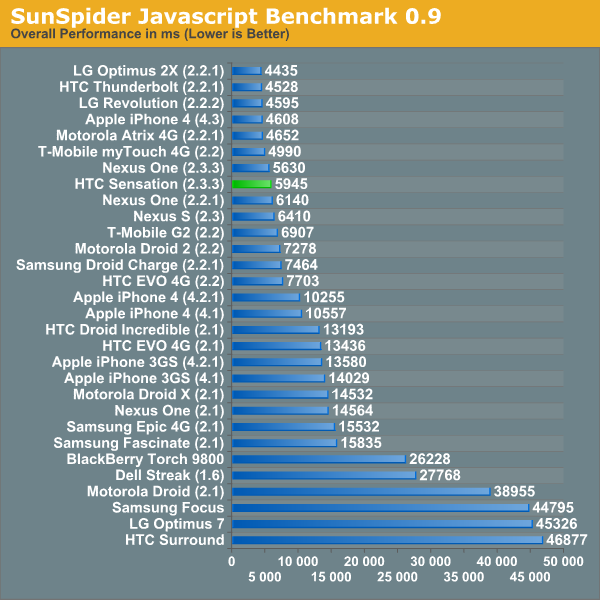
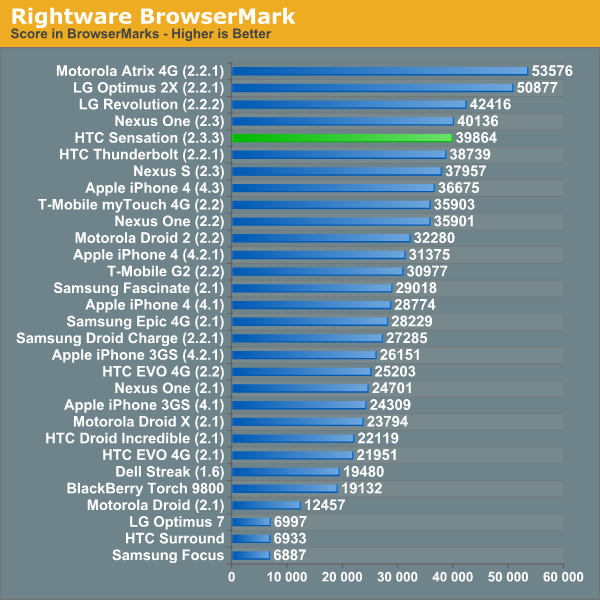
Flash is next, and here the Sensation delivers pretty good performance. It’s hard to make a direct comparison against the Optimus 2X again because we’re dealing with WVGA versus qHD, and we run this test aspect scaled.
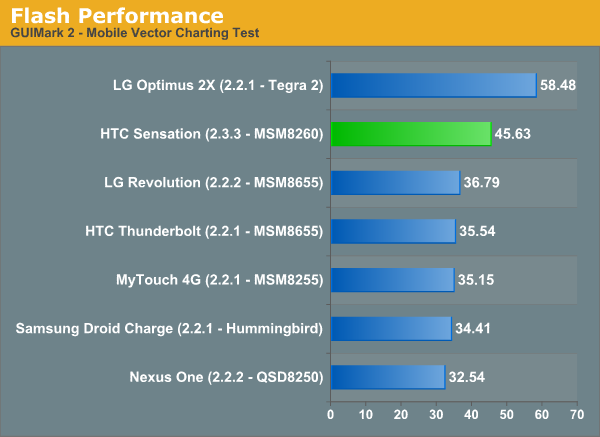
I’m putting Neocore up next because I want to mention again that we’re capped at vsync. We had some hope for a while that we could turn vsync off on handsets, however this is only possible on development hardware, not final ROMs that ship in devices. Odds are you won’t see this pop up again in our suite unless we can make it actually say something. We’re at the Surround’s 60fps wall even at qHD.
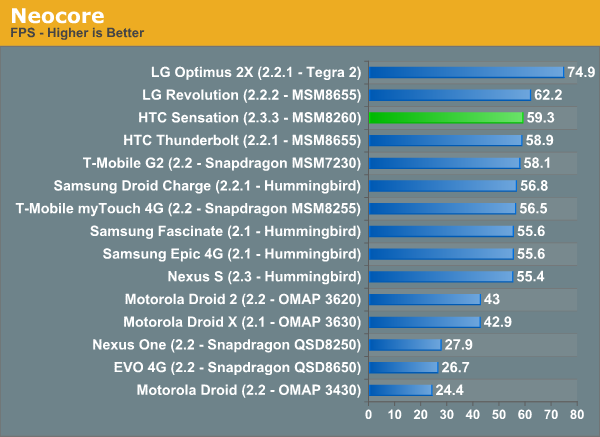
GLBenchmark 2.0 is a mainstay in our benchmarking section, and I’ve already broken down results in our HTC Sensation hands on back at Uplinq. Things have actually improved a bit since that hurried benchmark run over dinner in San Diego, with the Sensation posting around 2fps higher in Egypt and Pro. Again keep in mind the resolution differences between everything here, there’s a 1.35x increase in pixels going from WVGA to qHD.
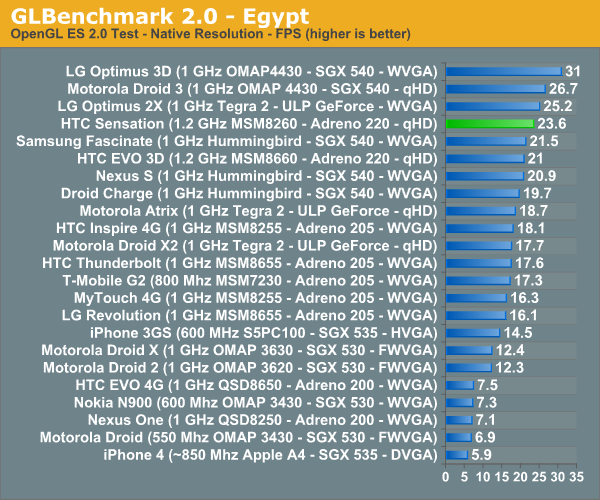
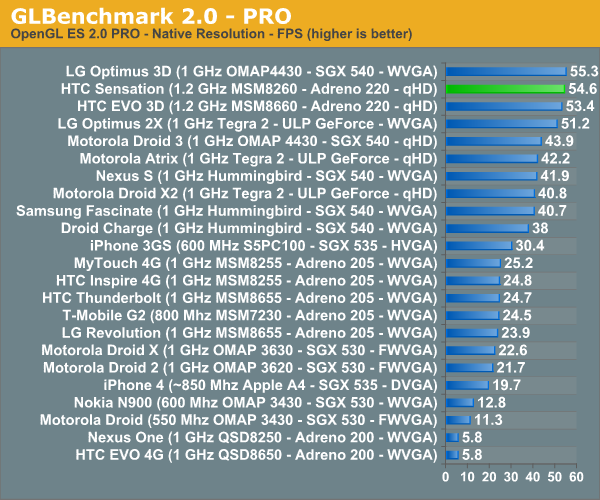
Next is BaseMark ES2.0, which is a nominally updated version of the hugely popular, industry-standard 3DMarkMobile ES2.0. Here we run at the default resolution, which is VGA, and thus get a picture without being constrained to just native resolution constantly. This one is a bit new for us, and I expect that Anand and I are going to explain things a bit more in the EVO 3D story. For now, just take away that MSM8x60 appears very speedy.
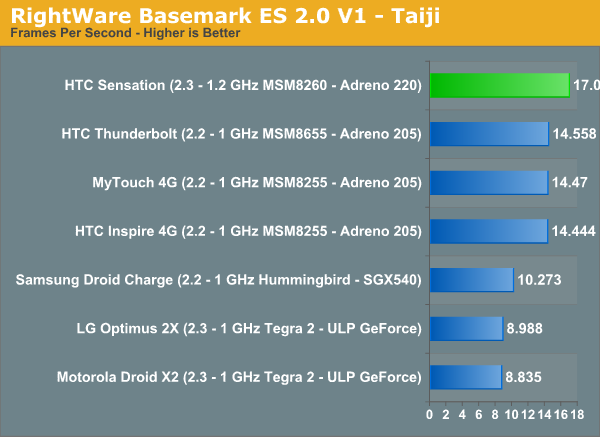
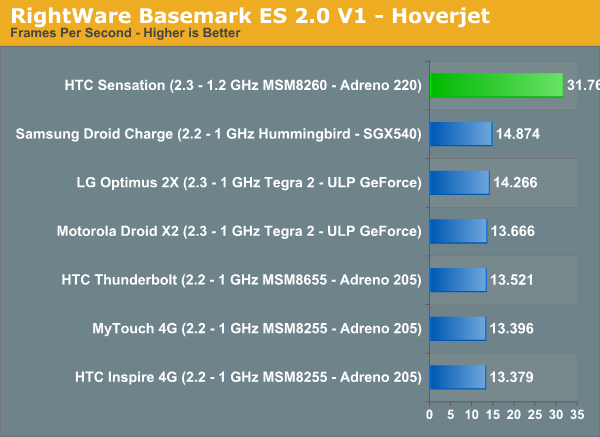
The Android port of Quake 3 is what we sort of started all of this mobile 3D benchmarking with, and we’re still running it even if it’s starting to hit vsync. The results look strange here until you realize that this is again running at native qHD resolution on the Sensation.
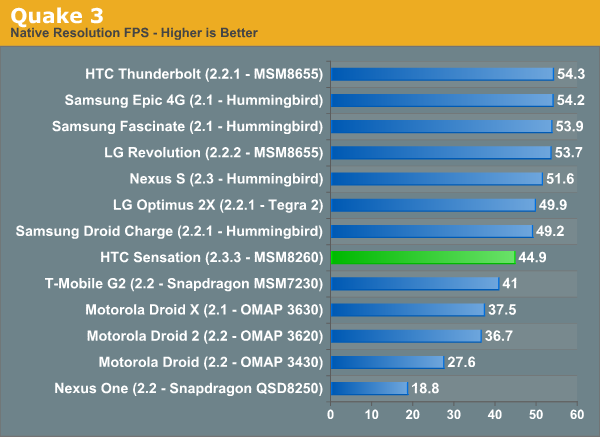
Next up is Linpack, which added a multi-threaded benchmark mode earlier this week. I’ve run it on all the dual core devices I could get my hands on. The initial multi-threaded version had some issues which were fixed on Tuesday, giving more accurate results. We’ll still run the single-threaded version alongside. The 20% jump in clocks shows itself nicely on the Sensation in single-threaded linpack compared to all those 1 GHz MSM8x55 phones we’ve tested.
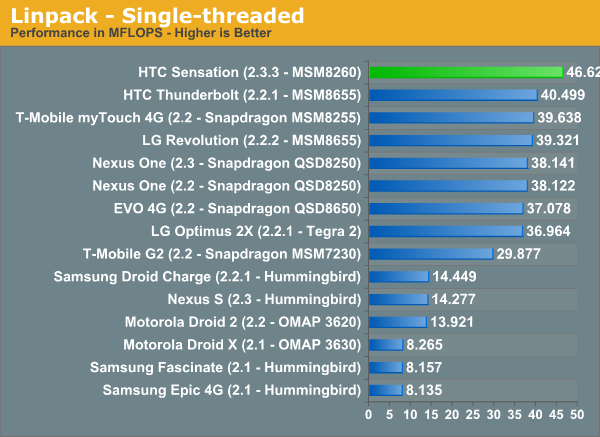
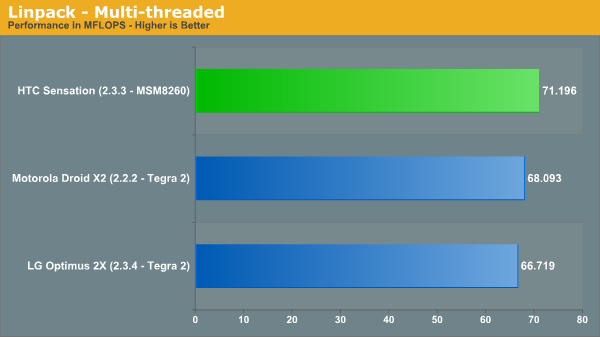
Last and most definitely least is Quadrant, which I think we've gone over our numerous reasons for disliking a few times. The tests themselves are starting to look seriously dated, including 3D tests which render improperly on Android 2.3 and are themselves up against the 60fps vsync cap through their respective runs. I'm sure that the rest of the poorly documented subtests are equally as subpar, however it's become something of a de-facto standard in certain circles.
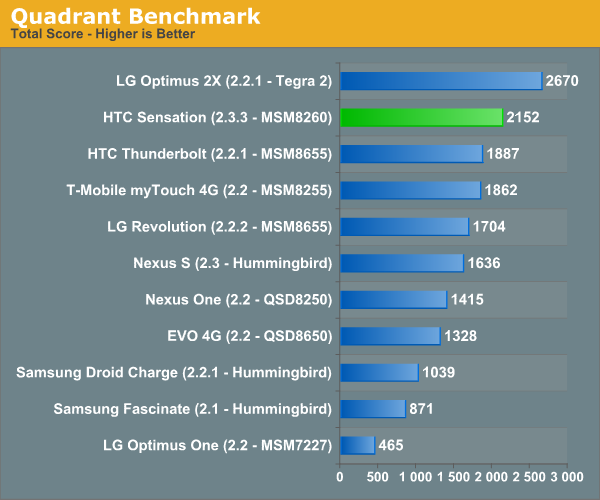
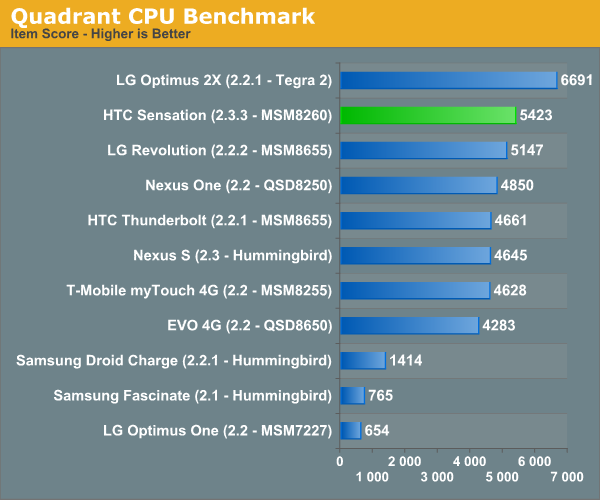
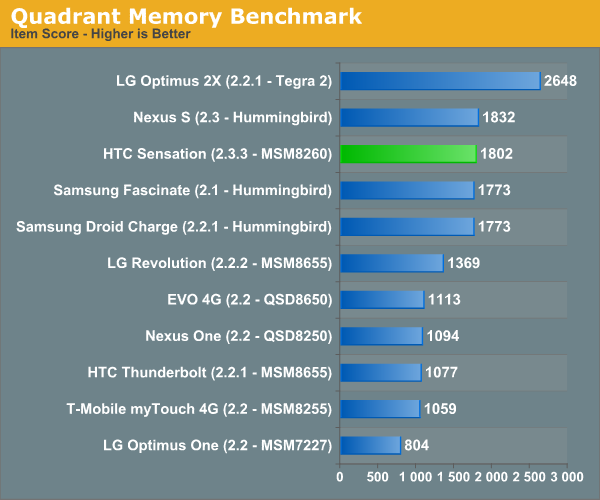
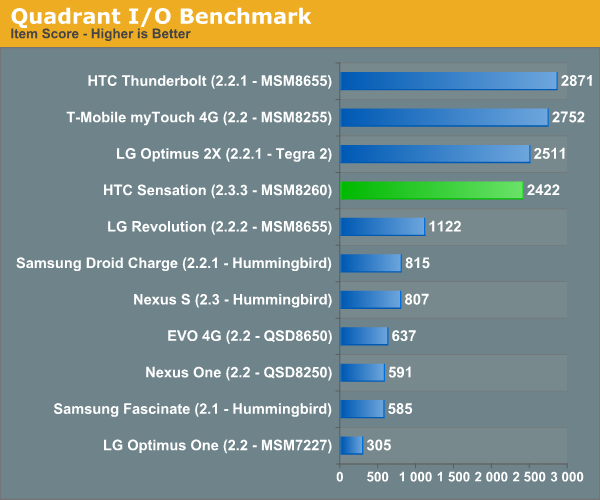
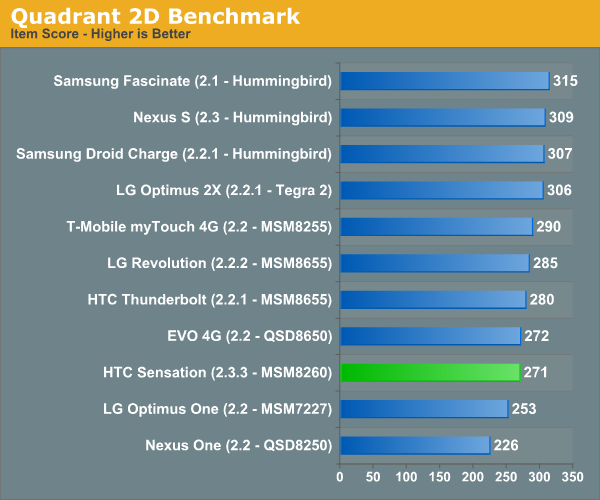
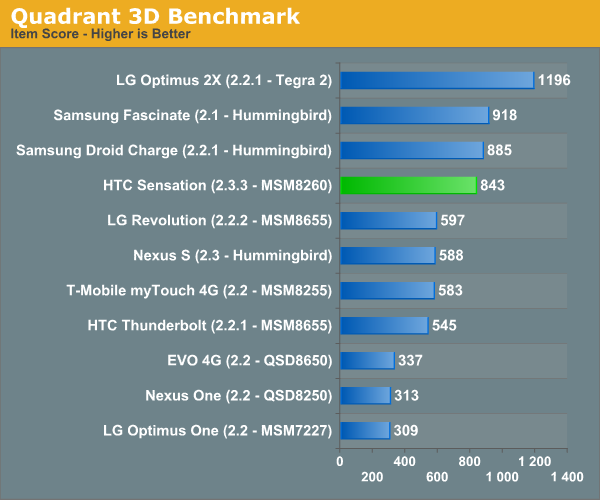
As an aside, I don't think we'll see Quadrant around for much longer, as there are better, more robust, fully documented tools by some established big names coming to the Android market (for free) shortly. All of those will probably quickly and thankfully replace Quadrant, as they all are gunning for its "go-to standard" status as the tool everyone runs, at least from the Android market. I have no doubt they'll quickly succeed.
The state of benchmarking on Android right now is a bit unbalanced, and what everyone wants is a system trace or general use benchmark that will show more than how the CPU does in synthetics and the GPU in synthetics. I fully expect all of that to change this calendar year. Just be patient.










107 Comments
View All Comments
synaesthetic - Sunday, July 3, 2011 - link
No SGS2 on AWS bands. :(coolhardware - Saturday, July 2, 2011 - link
Nice review. Never thought I'd see a gf discussion be the first comment posts on an AT article ;-)A note on the Sensation, it is supposed to be capable of 1080p MKV playback!
http://www.jdhodges.com/2011/06/can-android-do-108...
And of course the 1080p recording is pimptastic too:
http://www.google.com/search?sourceid=chrome&i...
Overall a pretty sweet phone IMHO :-)
mutu - Saturday, July 2, 2011 - link
pls review Samsung galaxy S2.Penti - Saturday, July 2, 2011 - link
Not to nitpick but why is it even called 4G? It's simply a 14.4Mbps device, we have 32Mbit (advertised speed) HSPA+ for "mobile broadband" here in Sweden, and nobody would care much what speed the cell phone is able to use and nobody tries to pass it as anything else. It's simply called HTC Sensation over here in Europe. Do not yet have 4G in my very little town, but 32Mbit HSPA+ is here. Expect 4G even out here in this market within a year or so though. Sooner in neighboring towns. Guess it's a good thing AT&T are picking up T-mobile USA. We will still need HSPA/+ for a while, but we are quickly moving on. Sure you could also opt for a WiMAX 16m network and the handsets is about as immature, but you need to be building your next gen network now.synaesthetic - Sunday, July 3, 2011 - link
The "4G" is T-Mobile US silly marketing speak that means nothing, of course. They tack 4G on the end of every phone with an HSPA radio capable of more than 7.2Mbps peak downstream.Penti - Sunday, July 3, 2011 - link
Yeah I know that, but why not just call it "Our old network till we get picked up by AT&T"? It's clear why they are without a next gen plan. Their customers need to be picked up by another operator for that to happen.synaesthetic - Sunday, July 3, 2011 - link
Until it's unlocked, I won't buy it.tejagamer - Sunday, July 3, 2011 - link
Excellent Review.. As usual..Now waiting for your comparison of SGS2 vs O2x vs Sensation and the SGS2 review..
bubblesmoney - Sunday, July 3, 2011 - link
Hi Brian,When you review the SGS2 please compare the internal memory on it to the internal memory available on other top of the line android handsets. This is an important limitation on android handsets which are not rooted +/- rommed to overcome the app2internal memory problem of android. Full time Android users [not part time android reviewers :) ] will appreciate what i mean. None of the reviews of android handsets bother to cover this problem users of stock handsets face if they dont root their handsets.
Handsets made by the likes of HTC severely skimp on the internal memory, more specifically the internal memory partitioned and kept for loading apps. On just a year old HTC Desire the partition available for apps is just a measly 147mb. Even on the HTC sensation it is just about 1gb. Compare this to the year old samsung galaxy s which has 1.8gb available for apps. The samsung galaxy s2 also has about 1.9gb available for apps from its 16gb/32gb internal memory. The HTC low internal memory problem does not go away by buying a 32gb card as the card is useless for apps that go on internal memory. The only option on HTC handsets which ALWAYS come with low internal memory compared to the competition (internal memory partition available for apps) is to buy a non HTC handset or to root and get rid of the problem or to use the sdk method described on xda forums.
For a reviews of android handsets it is vital that the internal memory is compared too in a comparison chart and more specifically the internal memory available for apps need comparing too. Please exclude the useless microsd cards supplied with handsets as that is useless for apps that dont go to sd card. Hope you provide such comparison charts for future reviews of android handsets. When games by gameloft etc run into many MBs on internal memory, having internal memory of the likes of 147mb available for apps on the HTC desire will be crucial information especially for many android handset buyers.
Similarly the rear speaker quality being poor is another HTC hallmark in my opinion after owning 2 HTC handsets. But not sure if it is just a hardware issue or HTC software issue. But things get better after loading apps with equalisers (poweramp etc) and boosting the gain. This works later even if the said apps are deleted I think.
Software is nothing without good hardware, so i will be keeping away from HTC and go the samsung galaxys2 way. But I guess the compromise is the much poorer GPS reception on samsung galaxy s2 and other handsets made by samsung.
USB on the go needs to be mentioned as well as competitor handstes have this feature but not the HTC sensation.
Accessories like speaker docks, keyboard are an important differentating feature. Just have a look at the HTC website to see if their handsets can even find one speaker dock or even anywhere else on the net. These options will make a difference to buyers and need to be mentioned in handset reviews.
bubblesmoney - Sunday, July 3, 2011 - link
Brian,In another review they seem to be saying the speaker is good. see http://www.gsmarena.com/htc_sensation_vs_galaxy_si... see the link for detailed test results